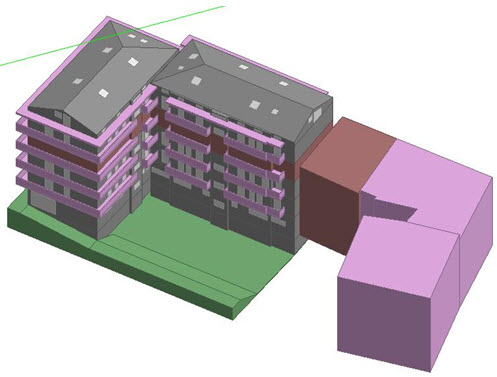We can help design teams plan for adequate levels of sunlight in both new and existing properties.
Ambient daylight is the volume of natural light that enters a building. All buildings are required to have adequate levels of daylight and this should be a priority for new developments – Daylighting Calculations are used for this purpose.It is important therefore to distinguish between daylight and sunlight in new developments.
Daylight or Sunlight?

Daylight from an overcast sky is generally the same no matter how the building is orientated. Sunlight on the other hand refers to direct sunshine and is very much brighter than ambient daylight.
On a cloudy or overcast day diffused daylight still shines through windows, even when sunlight is absent. Care especially needs to be taken when the development is situated to the south of existing buildings, as in the northern hemisphere, the majority of the sunlight comes from the south.
In the UK (and other northern hemisphere countries) south-facing facades will, in general, receive most sunlight, while north-facing facades will receive few sunlight hours during summer months, specifically early mornings and late evenings.
Sunlight levels are unlikely to be a determining factor for viability of new developments, but their analysis may assist an application.
How does sunlight analysis work?
Analysis is carried out following BRE guidance, British Standards, CIBSE design guides and established good practice for site layout.
It should be noted that this guidance is there to help rather than constrain the designer – they are not instruments of planning policy and are not mandatory. Planning authorities may wish to use their own targets.
Sunlight analysis allows us to establish the effect of proposed new development – that includes the effect on the new occupants and those existing occupants in neighbouring buildings.
 3D Modelling
3D Modelling
The first step is to build a 3D computer model. This model is built based on digital files, surveys and architectural drawings.
Where available some data may be taken from information available online. A full size model will be built of the existing area, including existing buildings and neighbouring properties.
Analysis of this model can then be carried out with a suite of different software modules.
Annual Probable Sunlight Hours (APSH)
APSH is an indicator used to demonstrate the percentage change before and after the proposed development.
It will be expected that the greater part of any overshadowing caused by a new extension should be confined to the applicant’s own land. The major factors that will affect the amount of overshadowing are height, distance to boundary, size of plot, orientation and topography.
Would you like to discuss your project?
Call us for a chat on 0330 055 34 05 or email be@buildenergy.co.uk.
